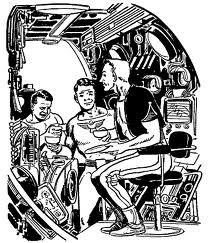
Six years ago I was hired by the University of Wisconsin to lead its development team on an internationally distributed open source project. Later a company named Qwaq was formed by project leaders and it later hired me and some of the other developers from various institutions. That company is now called Teleplace and its product sounds like science fiction, but it works. I’ve been blogging about the work since day one, and papers have been published by many people, but in the next six entries I’m going to try to bring together what I feel are the most significant accomplishments of all the various developers, and the science that has made them possible.
Credits:
Programmers: Farhad Anklesaria (U. Minnesota Office of Information Technology), Derek Arndt (UM), David Faught, Brad Fowlow (Teleplace), Bert Freudenberg, Matthew Fulmer (Duke Office of Information Technology), Josh Gargus (U. Wisconsin Division of Information Technology, TP), Rieko Kadobayashi (NICT), Jack Keel (UW), Craig Latta (Fuji Xerox PARC, TP), John Light (Intel Research), Corwin Light-Williams (Intel), Mark McCahill (UM, Duke), John David Miller (Intel), Eliot Miranda (TP), Peter Moore (UM), Yoshiki Ohshima (Viewpoints Research Institute), Andreas Raab (Hewlett Packard Laboratories, TP), David Reed (HP), Martin Shutze (UW), David Smith (VPRI, TP), Howard Stearns (UW, TP), Ron Stewart (UW), Ron Teitelbaum (TP), Liz Wendland (UM), Bob Westergard (TP), Takashi Yamamiya, Anthony Zampogna (UM), and the thousands who have worked on Squeak and Smalltalk.
Other Technical: Chris Croswhite (TP), Alan Kay (HP, VPRI), Yutaka Kidawara (NICT), Julian Lombardi (UW, Duke), Rick McGear (HP), Greg Nuyens (TP), Katsumi Tanaka (NICT), Keith Weng (TP)
Next: Done!
Related Posts:
- Why Canada's C-18 Isn't Working Out As Expected. by Harold July 24, 2023 Back at the end of June, Canada passed C-18, aka "The Online News Act," a law designed to make Google and Facebook negotiate with news…
- AI Policy and the Uncanny Valley Freakout. by Harold June 30, 2023 We have been debating, on and off, about the issues around artificial intelligence and AI governance for some time now. Here at Public Knowledge, we…
- My Insanely Long Field Guide to the Fox29 Philadelphia (WTFX-TV) License Renewal Challenge. by Harold August 29, 2023 In July, the Media and Democracy Project filed a Petition to Deny the license renewal of Fox29 (WTFX-TV) in Philadelphia. The Petition rests on a…
- S. Korea "Sender Pays" Is a Warning, Not a Model, or Why (Almost) Everyone Keeps Telling the EU This Is a VERY Bad Idea. by Harold October 14, 2022 Economist/NYT opinion writer Paul Krugman coined the term "Zombie idea" to describe an idea that, despite being repeatedly refuted with evidence, keeps coming back. Not…
- What is the FCC's Role in Artificial Intelligence? by Harold July 17, 2023 There are two types of public events here in DC. Those designed to actually educate people and those designed so that folks can display their…
- Gonzales v. Google Validates My Theory of Legislative Drafting -- Be Really, Really Detailed and Longwinded. by Harold February 15, 2023 Every now and then, I do some legislative drafting. I tend to get pushback on my habit of including a bunch of legislative findings and…

About Stearns
Howard Stearns works at High Fidelity, Inc., creating the metaverse.
Mr. Stearns has a quarter century experience in systems engineering, applications consulting, and management of advanced software technologies. He was the technical lead of University of Wisconsin's Croquet project, an ambitious project convened by computing pioneer Alan Kay to transform collaboration through 3D graphics and real-time, persistent shared spaces. The CAD integration products Mr. Stearns created for expert system pioneer ICAD set the market standard through IPO and acquisition by Oracle. The embedded systems he wrote helped transform the industrial diamond market. In the early 2000s, Mr. Stearns was named Technology Strategist for Curl, the only startup founded by WWW pioneer Tim Berners-Lee. An expert on programming languages and operating systems, Mr. Stearns created the Eclipse commercial Common Lisp programming implementation.
Mr. Stearns has two degrees from M.I.T., and has directed family businesses in early childhood education and publishing.




